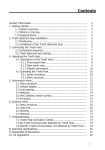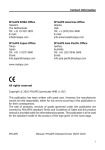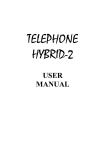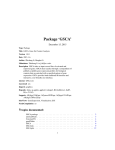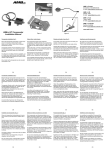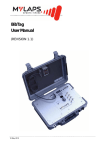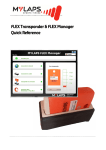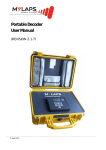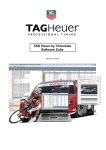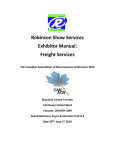Download MyLaps_ProChip_Manual_Dec2010
Transcript
Contents Contact information........................................... 2 1. introductioN...................................................... 3 2. Installation of the detection loop............ 4 2.1 Positioning the detection loop............................ 4 2.2 How to install correctly...................................... 6 1. Asphalt/ concrete, not permanent.................. 6 2. Ice.............................................................. 7 3. Snow........................................................... 7 2.3 Testing the detection loop.................................. 7 3. Installation of the Transponder................. 9 3.1 Positioning the transponder............................... 9 4. General remarks............................................... 10 Appendices Appendix A - FAQs.......................................................... 11 Appendix B - Useful tools........................................... 14 Appendix C - Technical Specifications..................... 15 Appendix D - EC and FCC regulations......................... 16 Guarantees & Warranties........................................... 17 Figures Figure 1.1 System overview............................................... 3 Figure 2.1 Detection loop installation overview.................... 5 Figure 3.1 MYLAPS ProChip Transponder............................. 9 1 Contact information MYLAPS EMEA Office Haarlem Haarlem The Netherlands Tel: +31 23 529 1893 E-mail: [email protected] MYLAPS Americas Office Atlanta USA Tel: +1 (678) 816 4000 E-mail: [email protected] MYLAPS Japan Office Tokyo Japan Tel: +81 3 5275 4600 Email: [email protected] MYLAPS Asia Pacific Office Sydney Australia Tel: +61 (0)2 9546 2606 Email: [email protected] www.mylaps.com All rights reserved Copyright © 2007-2010 MYLAPS (formerly AMB i.t.) This publication has been written with great care. However, the manufacturer cannot be held responsible, either for any errors occurring in this publication or for their consequences. The sale of products, services of goods governed under this publication are covered by MYLAPS’s standard Terms and Conditions of Sales and this product manual is provided solely for informational purposes. This publication is to be used for the standard model of the product of the type given on the cover page. MYLAPS 2 Manual: MYLAPS ProChip/01-2010 1: Introduction The MYLAPS ProChip timing system, previously the ChipX system, is designed for timing active sports including speed and inline skating, skiing, cycling, running, triathlon and more. The active detection loop continuously sends a signal to activate the transponder when crossing the loop, and the transponder then emits a signal which is picked up by the loop. The detection loop is connected by wire to the MYLAPS ProChip decoder. The decoder timestamps the received transponder signals and sends this data to a connected computer. The ProChip transponder can be attached to the competitor’s ankle by using a strap or attached to the competitor’s footwear by using shoelaces. It can also be attached to the competitor’s bicycle. Transponder Detection loop Power Headphone Computer Decoder Figure 1.1 System overview 3 2: Installation of the detection loop Proper installation of the detection loop is essential in achieving optimal system performance. Only approved MYLAPS ProChip system loops should be used. The use of any “homemade” loops can have an adverse effect on system integrity. Please reference figure 2.1 for a diagram of proper loop installation. 2.1 Positioning the detection loop 1. The ChipX system marks the passing time of a competitor when the transponder is in the exact center of the loop wires. Therefore the actual finish line should be located in the center middle of the detection loop wires, or at a point where the lead part of a competitor is at a constant distance from the transponder and adjusted accordingly. 2. The loop wires are laid across the width of the course in parallel to form a rectangle. 3. Make sure that the loop length is never less than 2m (6,6ft) or greater than 12m (36ft). 4. Always cover 30cm (1ft) more than the track width on each side to make sure that competitors never get closer than 30cm (1ft) to either end of the loop. 5. Do not leave wires or coaxial cables rolled up or tangled up as this may negatively affect system performance. 6. For competitor and spectator safety as well as to avoid disconnections of the detection loops, always cover and protect loop wires and coaxial cables. 7. All metal in the environment of the loop may decrease the activation signal and transponder detection height significantly. Avoid installation above or near metal, including reinforced concrete. 8. Even though the coaxial cable to the loop is double shielded it is still possible for transponder signals to be received via the coaxial cable. Therefore keep the coaxial 4 cable at least 1m (3ft) away from areas where participants with transponders might pass. Example: In cycling events the competitor finishes when the leading edge of the bicycle’s front tire is right above the finish line. For correct installation, first measure the distance between the transponders and the leading edge of the front tire. Then position the middle of the loop wires in front of the finish line, at the exact same distance. This will ensure that the transponder is accurately scored at the same instant the leading edge of the front tire is right above the finish line. max. transponder height 90 cm (3 ft) AMB ProChip Transponder sponder FINISH LINE End Box 30 cm 60 cm or see decoder manual max. 12 m (36ft) Center of Loop Wires 30 cm Connection box Coaxial cable Figure 2.1 Detection loop installation overview 5 2.2 How to install correctly The ChipX detection loop is supplied with connectors. Do not use any other connectors than the ones supplied. The connectors are intended to be used for short term installations (up to 2 days). For longer term installation, solder the loop wires as described below. Note: The ProChip loop is not compatible with any other MYLAPS system loops. If you have a setup with multiple loops, keep the loops at least 10m (30ft) apart from each other. Be aware that even when the loops have some distance from each other, the transponder signal may transfer from one loop to another through surrounding metal. If this happens, you will receive the tranponder signals on both loops simultaneously. The detection loop is sensitive to interference that can be created by nearby cabling or picked up by nearby metal structures. When possible, keep other cables at least 5m (15ft) away. Also, make sure athletes on other parts of the track will not get closer than 5m (15ft) to the detection loop to avoid false inputs. The type of loop installation that is most suitable depends on the ground surface. Please follow the instructions according to the surface your loop in installed on. 1. Asphalt/concrete, not permanent (tape) Adhesive tape can be used to affix the loop wires to the course. We recommend industrial strength Polyken #203, Tesa 4651 or similar tape, 10cm (4inch) wide. Lay the tape over each loop wire, placing the wire in the center of the strip of tape and secure the tape to the road. 6 2. Ice Cut slots 2cm (1inch) deep in the ice. Put the loop wires in the slots and fill them with snow/water at least 12 hours prior to the start of the event to allow the slot to re-freeze. 3. Snow Cut slots in the snow, approximately 20cm (8inch) deep. Try to keep the slots as horizontal as possible. Put the loop wires in the slots and fill them with snow. Note: Make absolutely certain that the loop is installed securely to avoid possible injury to competitors and spectators from loose loop wires. 2.3 Testing the detection loop Once the loop has been installed, it should be tested to ensure that it is functioning correctly. Repeat the same procedure before each event. You can determine if your loop is functioning correctly by performing the following tests: 1. Connect the detection loop to the decoder and then check for any background noise (visible on the display, see your decoder manual). The background noise level is usually between 0 and 40 points. A higher value may indicate a bad loop installation or interference by other electrical equipment in the area. Try switching off any suspected equipment or removing nearby metal objects and check for improvements. 2. Check the signal strength of the transponders as they are picked up by the system during a test (also see paragraph 3.1 Installation of the Transponder). A good loop will yield consistent transponder signal strength of at least 100 points with a hit rate of at least 10 hits. The hit rate may vary depending on the speed of the transponder passings, as well as the height of the transponder as it passes over the loop (slower and lower passings may yield higher hit counts). Performance of the system depends 7 on the difference between the received signal strength of the transponder and the background noise level. Usually, if the transponder strength is more than 60 points higher than the background noise, the detection of the transponder will be reliable. 3. Check the detection height. The detection height will vary depending on correct installation of the detection loop and the presence of metal items in the vicinity of the loop and coaxial calbe. Metal in the vicinity of the coaxial cable and loop may weaken the activation field and consequently decrease the detection height. Examples are reinforced concrete floors or ice rink floors with cooling installations. To measure detection height, connect headphones or a speaker to the decoder. Stand in the middle of the detection loop and hold up a ProChip transponder as high as possible. Slowly move the transponder toward the ground. Determine the detection height by listening for the beep. Note: In case of reinforced concrete floor or other metal below, the transponders may need to be placed a maximum of 30cm (1ft) above the track. 8 3. Transponder installation 3.1 Installation of the transponder The MYLAPS ProChip transponder contains a permanent battery and therefore does not need to be recharged. This ensures reliable and maintenance-free operation. When the transponder passes the detection loop, it is automatically activated and switched off after each detection. Positioning the transponder The position of the transponder must be identical for all competitors in the race to ensure consistent timing. The MYLAPS ProChip transponder can be attached to the competitor’s ankle by using a strap or attached to the competitor’s footwear by using shoelaces. It can also be attached to the competitor’s bicycle. Inform the competitors of the correct location of the transponder to avoid transponders not being detected during the race. Figure 3.1 The MYLAPS ProChip transponder 9 4 : General Remarks Keep transponders away from cabling or electrical equipment to maximize transponder and battery life. Keep in mind that wires and metal objects transfer transponder signals. This may cause the system to detect transponders even at a significant distance. Keep extra transponders away from the loop and decoder to avoid unwanted passings during an event. For optimal performance at low temperatures, it is advisable to keep the transponders as warm as possible during a race (e.g. keep it under clothing). Preferred storage of the equipment is at room temperature. 10 Appendix A : FAQs A1: Transponder not being detected A few of the transponders are not being detected. If this is the case, the problem is most likely related to the transponder or the positioning of the transponder. - Check the position of the transponder, refer to paragraph 3.1. None of the transponders are being detected. If this is the case, the problem is most likely related to the detection loop, decoder, timing computer or cabling. Please take the following steps: - Check if a beep is heard in the headphone, or if the loop in the decoder display changes to black during a transponder passing. If this is working, and the computer screen appears blank, check the cabling between the decoder and the computer. - Check the coaxial cable by measuring the resistance (with multimeter) between the center pin and the outside of the BNC connector. The reading should be approximately 150 kOhm after 30 seconds. If not, the coaxial must be replaced. - Check the loop wire measuring the resistance between the loop wires in the track. The reading should be approximately 220 Ohm. If this is not the case, the loop must be replaced. A2: Noise levels What if my background noise is higher than 40 points? An increased background noise is an indication of a higher interference level picked up by the system. Every five seconds, a background noise measurement is performed by the 11 decoder and sent to the computer. The noise level should be as low as possible, but as long as the received signal from the transponders is 60 points higher then the noise level, detection will be reliable. If the noise level is higher than 70 there is most likely something wrong with the installation. Possible causes of high background noise levels: - When the detection loop is damaged, a fluctuation in noise level will be noticeable, especially in wet conditions. If this is the case, check the loop wire and coaxial for cuts or breakage. -Electrical equipment too close (<3 m) to the loop or coaxial cable. - Use of a generator with a poor ground connection. - Use of DC/AC converter for AC power. - Poor connections between the detection loop and the coaxial cable. - BNC connector incorrectly fitted to the coaxial cable. - Poor ground connection of the AC power. If this is the case, ground the decoder by connecting the outside of the BNC connectors on the decoder to a piece of metal (copper rod or tube) that is in a fixed connection with the ground. Troubleshooting Tips for High Noise Levels 1. Be sure to keep ALL non-MYLAPS wires (including power wires) at least 30 ft. away from the loop. 2. Try using a different power supply. 3. Try moving the existing loop around and see if the noise level drops. There may be power cables underneath the ground that could cause higher noise levels. 4. Try moving the loop. 5. Try using a new loop wire. 6. Try using another MYLAPS decoder 12 A3: Signal strength What if the received signal strength is below 100 points? - If the signal strength is lower that 100 points, please check the position of the transponder. - If the signal strength is fluctuating heavily in combination with high noise levels, check the quality of the loop installation and coaxial cables. If you have any questions or remarks please contact MYLAPS Sports Timing. You can find our contact details on page 2 of this manual. 13 Appendix B: Usefool tools Useful Tools Resistance meter (Range at least: 1 Ohm - 1 Mega Ohm) Wire cutter/stripper BNC Crimper (Butane) Soldering gun Blade knife Coax stripper Ice pick Screw driver (normal and Phillips) Shrinksleeve Useful Spare Parts BNC couplers (3 pieces) Thick BNC connectors (5 pieces) Spare loops (6, 9, or 12 m) Additional Tools for new loop installations Polyken #203 4 inch-wide tape/ Tesa 4651 Chalk line Caulk gun Please contact MYLAPS Sports Timing if you would like to receive detailed specifications on any of the above items. 14 Appendix C: Technical Specifications MYLAPS ProChip Transponder Numbers available : unlimited Fixation : several options like ankle strap or shoe lace Dimensions : 37 mm diameter x 13 mm Weight transponder : 16 g Housing : Water- and shockproof Max. speed : 75 km/h Timing Resolution : 0.004 sec Temperature range : -20 to 50 °C (-4 to 122 °F) Operating time : approx. 120,000 loop passings Signal transfer : magnetic induction Detection Height : max. detection height 90 cm ( 3 ft) Detection Loop Track width Loop width Coax to decoder Loop wire : 2-12m (10-36ft) : 60cm (2ft) *see decoder manual : max. 100m (330ft) double shielded : d=3 mm (1/8 in), tinned copper, 0.75 mm² (18 AWG) Specifications are subject to change without notice. 15 Appendix D: CE and FCC regulations CE information: This device complies with the EMC directive 89/336/EEC. A copy of the declaration of conformity can be obtained at: MYLAPS Sports Timing Zuiderhoutlaan 4 2012 PJ Haarlem The Netherlands FCC information: This equipment complies with part 15 of the FCC rules. Operation is subject to the following two conditions: (1) This equipment may not cause harmful interference, and (2) this equipment must accept any interference received, including interference that may cause undesired operation. 16 Guarantees & Warranties MYLAPS, formerly AMB, warrants that, for a period of three (3) years from the date of shipping the decoders and the MYLAPS MX Rechargeable Power (AMBmx), MYLAPS RC DP (AMBrc DP), MYLAPS KART DP (TranX160 DP), MYLAPS Kart Rechargeable Power (TranX160), MYLAPS Car/Bike DP (TranX260 DP), MYLAPS Car/Bike Rechargeable Power (TranX260), MYLAPS Car/Bike Pro (TranX Pro) transponders covered by this warranty with defects, as determined solely by MYLAPS, caused by faulty materials, workmanship or design will be repaired or replaced, unless such defects were the result of any of the following: shipping; improper installation, maintenance or use; abnormal conditions of operation; attempted modification or repair by the customer or any third party; use of the goods in combination with other items; or an act of God. If repair or replacement of the goods is not possible or economical for MYLAPS, MYLAPS may, at its option, refund the purchase price of the goods or deliver replacement goods at its sole discretion. MYLAPS’s liability shall be strictly limited to replacing, repairing or issuing credits at its option. MYLAPS warrants that, for a period of two (2) years from the date of shipping the ProChip, MYLAPS Kart Fixed Power (TranX140) and the MYLAPS RC Rechargeable Power (AMBrc) transponders covered by this warranty with defects, as determined solely by MYLAPS, caused by faulty materials, workmanship or design will be repaired or replaced, unless such defects were the result of any of the following: shipping; improper installation, maintenance or use; abnormal conditions of operation; attempted modification or repair by the customer or any third party; use of the goods in combination with other items; or an act of God. If repair or replacement of the goods is not possible or economical for MYLAPS, MYLAPS may, at its option, refund the purchase price of the goods or deliver replacement goods at its sole discretion. MYLAPS’s liability shall be strictly limited to replacing, repairing or issuing credits at its option. MYLAPS warrants that, for a period of one (1) year from the date of shipping the MYLAPS Onboard Display kit (TnetX Display Kit) covered by this warranty with defects, as determined solely by MYLAPS, caused by faulty materials, workmanship or design will be repaired or replaced, unless such defects were the result of any of the following: shipping; improper installation, maintenance or use; abnormal conditions of operation; attempted modification or repair by the customer or any third party; use of the goods in combination with other items; or an act of God. If repair or replacement of the goods is not possible or economical for MYLAPS, MYLAPS may, at its option, refund the purchase price of the goods or deliver replacement goods at its sole discretion. MYLAPS’s liability shall be strictly limited to replacing, repairing or issuing credits at its option. MYLAPS warrants that, for a period of one (1) year from the date of shipping, all other goods covered by this warranty with defects, as determined solely by MYLAPS, caused by faulty materials, workmanship or design will be repaired or replaced, unless such defects were the result of any of the following: shipping; improper installation, maintenance or use; abnormal conditions of operation; attempted modification or repair by the customer or any third party; use of the goods in combination with other items; or an act of God. If repair or replacement of the goods is not possible or economical for MYLAPS, MYLAPS may, at its option, refund the purchase price of the goods or deliver replacement goods at its sole discretion. MYLAPS’s liability shall be strictly limited to replacing, repairing or issuing credits at its option. If the requirements set forth above and described under Remedies and Damages are not complied with, our warranty/guarantee shall not apply and we shall be discharged from all liability arising from the supply of defective goods. 17 EXCEPT AS EXPRESSLY PROVIDED IN THIS SECTION, MYLAPS MAKES NO REPRESENTATIONS OR WARRANTIES OF ANY KIND, NATURE OR DESCRIPTION, EXPRESS OR IMPLIED, INCLUDING WITHOUT LIMITATION, ANY WARRANTY OR MERCHANTABILITY, FITNESS OF THE GOODS FOR ANY PARTICULAR PURPOSE, OR NONINFRINGEMENT, AND MYLAPS HEREBY DISCLAIMS THE SAME. Remedies and Damages 1. MYLAPS shall not incur any liability under the above warranty unless: i) MYLAPS is promptly notified in writing upon discovery by the customer that such goods do not conform to the warranty, and the appropriate invoice number and date of purchase information is supplied; ii) The alleged defective goods are returned to MYLAPS carriage pre-paid; iii) Examination by MYLAPS of goods shall confirm that the alleged defect exists and has not been caused by unauthorized use (including, without limitation, the use of an AMB decoder with non-MYLAPS hardware) misuse, neglect, method of storage, faulty installation, handling, or by alteration or accident; and iv) With respect to MYLAPS decoders, customer has upgraded the firmware in its decoder within one month after MYLAPS has offered to provide customer with such upgraded firmware. 2. The customer acknowledges that the goods may include certain firmware imbedded therein. MYLAPS hereby grants a license to customer to use the imbedded firmware in an MYLAPS decoder, but only to the extent the decoder is used in connection with MYLAPS hardware. MYLAPS shall have the right to terminate the license immediately upon written notice to customer in case MYLAPS has a reasonable belief that customer at any time has used the MYLAPS decoder in connection with non-AMB hardware. Further, customer may not copy, compile, reverse compile, disassemble, translate, analyze, reverse engineer or attempt to reverse engineer the firmware, except as permitted by applicable law. 3. In addition, customer grants MYLAPS the option to repurchase any MYLAPS decoder if MYLAPS has a reasonable belief that customer has used the MYLAPS decoder in connection with non-MYLAPS hardware. The repurchase price shall be the fair market value on the date MYLAPS provides notice to customer that it intends to repurchase the decoder. The above mentioned warranty/guarantee is irrespective of any rights granted to the buyer of MYLAPS equipment manufactured or sold by MYLAPS based on the laws of the Netherlands. Any correspondence regarding the above mentioned guarantee must be addressed to MYLAPS: MYLAPS EMEA OFFICE HAARLEM Zuiderhoutlaan 4 2012 PJ HAARLEM THE NETHERLANDS E-mail: [email protected] Fax: +31 23 529 0156 18


















